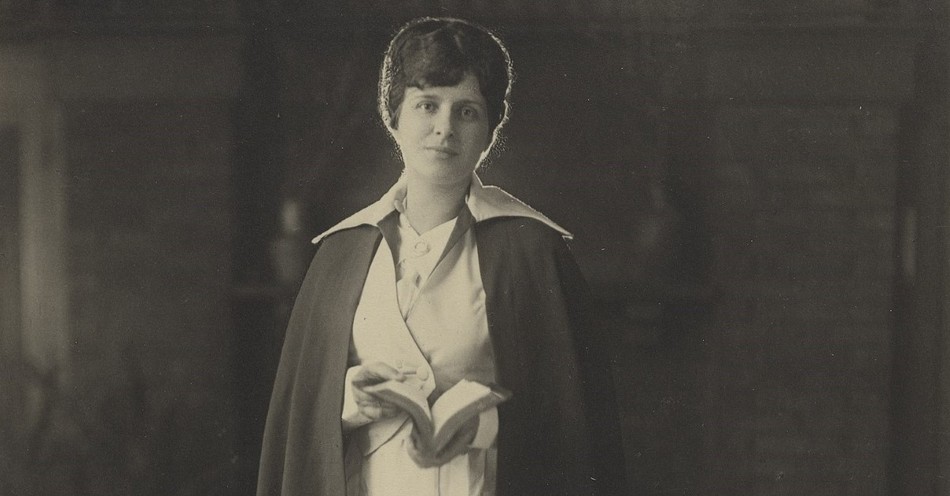Aimee Semple McPherson was not the first female evangelist to step into the pulpit, but she’s by far the most famous—and perhaps the most infamous.
During the onset of Hollywood’s golden age, she amazed audiences by co-opting Tinseltown-style theatrics to flesh out her sermons. Despite claims that her zany antics sensationalized the sacred, thousands stormed the prayer rails to receive Christ during her revival tours.
By 1920, Aimee had gained a celebrity-sized platform to spread the Gospel message. But at the zenith of her career, a personal scandal that played out in the media like a melodrama made many question whether Aimee was a saint or a charlatan.
Aimee Semple McPherson’s Early Life
Born in Ontario, Canada, in 1890, Aimee Elizabeth Kennedy was the only child of James Kennedy, a devout Methodist, and Mildred Kennedy, a dedicated member of the Salvation Army.
Mildred, also known as Minnie, was 15 when she married 50-year-old James. As she grew older, she regretted that marriage had hindered her ability to serve in the Salvation Army.
Daniel Mark Epstein’s book Sister Aimee: The Life of Aimee Semple McPherson reports that when Minnie became pregnant with her first child, Minnie prayed, “God, If You will only hear my prayer, as You heard Hannah’s prayer of old, and give me a little baby girl, I will give her unreservedly into your service, that she may preach the word I should have preached, fill the place I should have filled, and live the life I should have lived in Thy service.”
When Did Aimee Semple McPherson Become a Christian?
In 1907, Aimee met Robert James Semple, an Irish Pentecostal missionary whose passionate preaching opened the gospel’s truth to her as never before. After hearing one of his sermons, she received Christ as her Savior. Aimee was overwhelmed with gratitude for her salvation and asked God how to serve Him further. When she opened her Bible to Proverbs 11:30, she felt God had answered her prayer and was leading her to a life of soul-winning and preaching.
She and Robert met frequently to discuss spiritual matters, especially the tenets of Pentecostalism. Aimee became fascinated with the idea of receiving the baptism of the Holy Spirit. She believed she would be “transformed into an evangelist of power” through this filling.
After three days of praying and waiting on the Lord, she received the power she had hoped for and began speaking in tongues.
What Did Aimee Semple McPherson Do Before She Became an Evangelist?
In 1908, Aimee married Robert Semple. The newlyweds moved to Chicago in 1909 and were both ordained by the Reverend William Durham before heading to China on an independent missionary journey.
Less than two months after they arrived in China, they both fell seriously ill, and Robert died from dysentery. Aimee grieved Robert’s death while recovering from malaria and carrying their child to term. One month after Robert’s passing, Aimee gave birth to their daughter, Roberta Star. She and the frail baby left China to travel to New York, where they shared a one-bedroom apartment with Aimee’s mother, who had recently separated from her husband.
In New York, Aimee met young accountant Harold Steward McPherson. In 1912, they married. A year later, Aimee gave birth to her second child, Rolf, and immediately fell into deep depression. Feeling trapped in her life as a homemaker, she isolated herself in darkness for days and lamented over her heavy burden to preach.
In 1914, she was hospitalized. Aimee asserts in her autobiography that in the hospital, she heard God ask, “Now will you go?” Believing that God would kill her if she did not fulfill her calling to preach, she answered, “Yes, Lord, I’ll go!”
Aimee fully recovered. After leaving the hospital, she also left her husband. Aimee and the two children traveled to her childhood home in Canada and sent Harold a telegram. “I tried to walk your way and failed,” she said. “Won’t you come now and walk my way? I’m sure we will be happy.”
Harold eventually joined Aimee and helped with her evangelistic campaign. But in 1921, he filed for divorce, citing abandonment.
How Did Aimee Semple McPherson’s Evangelism Ministry Begin?
In Canada, Minnie and James promptly took charge of the children and urged Aimee to attend a Pentecostal camp meeting in a neighboring town. There, she knelt and dedicated her life to evangelism. She met resistance when she tried to offer a prayer of repentance.
“I was the first one down at the mourner’s bench. Brokenly I began to sob, ‘Oh Jesus, forgive me! For—’
‘Before I could finish the words it seemed as though the Lord had placed his hand over my trembling lips, saying ‘There, there, my child. Say no more about it.’” — Aimee: The Life Story of Aimee Semple Mcpherson, edited by Raymond L. Cox
Penniless but full of faith, Aimee began touring. She preached in makeshift revival tents across the sawdust trail. During an era when the country’s religious fervor had waned, Aimee’s preaching drew massive crowds. Thousands rushed forward to receive salvation during her altar calls.
What Happened During the Peak of Aimee Semple McPherson’s Ministry?
News of God healing the sick through Aimee’s prayers of faith spread like wildfire. Skeptical reporters from all over the nation flocked to her gatherings and left bewildered when they witnessed healings occur before their eyes.
The humble meeting tents disappeared. Minnie, who now managed her daughter’s ministry, discovered that not even the largest auditoriums and stadiums could contain the hordes who clamored for Aimee’s attention. During one of Aimee’s revival tours in San Diego, the National Guard was dispatched to control a crowd of 30,000.
Aimee continued her revival tours during the 1918 influenza outbreak, even after she and her children contracted the disease. Night after night, she staggered to the pulpit to preach and pray despite her raging fever.
When she returned home from a meeting to discover that Roberta had taken a turn for the worse, Aimee cried out to God to spare her daughter’s life. God appeared to her in vision to say that not only would her daughter live, but that He would provide them a home in Los Angeles, where her family could thrive.
Upon Roberta’s recovery, the family moved to Los Angeles, where Aimee’s ministry hit even bigger heights of success.
Epstein writes that Aimee’s 1919-1922 revival events “had a mass appeal unequaled by any touring phenomenon of theater or politics in American history. Neither Houdini nor Teddy Roosevelt had such an audience, nor P.T. Barnum.”
Within two years of the move to Los Angeles, her new followers provided the land, funds, and labor to build the family home God had promised, with enough left over to break ground for a permanent building for her revival meetings.
During this season of ministry, Aimee’s influence crossed ethnic, cultural, and political boundaries. Public officials and spiritual leaders worldwide desired an audience with her. She was the first woman to purchase a radio station (KFSG in Los Angeles, in 1924) to preach the gospel and the first woman to found a Bible college (Life Pacific University, in 1923).
Not everyone wanted to participate in her fan club. Critics questioned Aimee’s flamboyant style, marital status, doctrine, and unofficial affiliation with the Pentecostal church. In 1922, Aimee clarified her convictions as a “full Gospel, based on Jesus the Savior, Jesus the Baptizer with the Holy Spirit, Jesus the Healer, and Jesus the coming King.” This Foursquare Gospel became the overall theme for her revival ministry and would become the distinctive brand for her new Los Angeles evangelistic center (still active today).
In 1923, Angelus Temple opened its doors debt-free, thanks to the generous donations collected from Aimee’s followers. The million-dollar, dome-shaped building was the largest of its kind in North America. On opening day, attendance reached 10,000 people. Forty million others would visit the Temple within the first seven years of the grand opening.
Controversies Surrounding Aimee Semple McPherson’s Life and Ministry
In 1926, at the height of her success, Aimee vanished while swimming at Ocean Park Beach. Rescue workers and devastated followers searched the ocean for her body to no avail. Word of Aimee’s disappearance spread worldwide, and rumors about her whereabouts ran rampant in the media.
The press speculated that Aimee might be hiding with Kenneth Ormiston, a married employee of Aimee’s radio station. But most suspected her disappearance was just another elaborate publicity stunt.
Five weeks later, Aimee reemerged in a small Mexican town near Arizona. She claimed she had escaped from kidnappers who had held her prisoner in a desert shack to collect a ransom from Angeles Temple. Her story met with more than a little skepticism. Nevertheless, upon her return, over 50,000 jubilant fans greeted Aimee at the Los Angeles train station.
L.A.’s district attorney attempted to indict Aimee for conspiracy to commit a hoax, but they dropped the case when witnesses proved unreliable. After months of grueling testimony, Aimee’s story never wavered. Still, very few believed the outlandish tale. The press, who had once branded her a saint, were now determined to prove her a sinner.
Aimee’s unfolding family drama gave them plenty of content to spin. Aimee and her mother had presented a unified front throughout the grand jury investigation. Still, beneath it all, tension brewed over who would control Angelus Temple’s inner workings—and who would control Aimee. Minnie warned her daughter to maintain a low profile until the controversy died, but Aimee insisted on remaining in the limelight.
In 1927, less than a month after charges against her were dropped, Aimee embarked on a flashy, nationwide “vindication tour.” She traded her matronly pastoral garb for figure-skimming silk dresses and fashionable furs. Her long, thick hair was shorn to a bob, and she began wearing makeup and jewelry. Perhaps most shocking to her conservative followers was that Aimee, a nonsmoking teetotaler, added speakeasies and nightclubs to her new tour schedule. From 1927 to 1936, Aimee’s notoriety grew as newspapers ran titillating stories about the dramatic change in her persona.
Despite negative press coverage, her faithful followers remained true to Aimee. She continued to share the gospel, advocate for racial equality, feed the hungry during the Great Depression, and later supported American soldiers fighting in World War II.
Aimee’s new glitz and glam persona wreaked havoc on her relationship with her mother. The two had a series of volatile fallouts until their last dispute in August 1930 landed Minnie in the hospital with a broken nose, leaving the two women irreparably estranged. One month later, Aimee suffered a physical and nervous breakdown and was forced to retreat from the pulpit.
By November 1930, Aimee returned full force to ministry. With a massive crew of set designers, stagehands, and musicians, she toured and preached 336 sermons to two million people nationwide. She married her third husband, David Hutton, in September 1931, but they divorced a few years later.
In September of 1944, she was due to preach to a massive revival crowd in Oakland, California, but her son found her unconscious in her hotel room. Shortly after, Aimee Semple McPherson died from an accidental overdose of prescribed sleeping pills.
Over 40,000 people waited in line to view the beloved evangelist’s body as it lay in state at Angeles Temple. And it took nearly a dozen transport trucks to remove the flowers from her gravesite after they laid her to rest.
Aimee Semple McPherson’s life was full of miracles—and mayhem. The high price of fame is often the drama that accompanies it. To this day, few agree on whether the flamboyant evangelist should be labeled a saint or charlatan. But none can deny that Aimee ushered in a new era of mass evangelism. Using mass media as her bullhorn and pop culture as her prop, she drew in a millions-person audience and shared the Good News of Jesus Christ with them.
Photo Credit: Public domain 1921 photo from the Gerhard Sisters Studio
This article is part of our People of Christianity catalog that features the stories, meaning, and significance of well-known people from the Bible and history. Here are some of the most popular articles for knowing important figures in Christianity:
How Did the Apostle Paul Die?
Who are the Nicolaitans in Revelation?
Who Was Deborah in the Bible?
Who Was Moses in the Bible?
King Solomon's Story in the Bible
Who Was Lot's Wife in the Bible?
Who Was Jezebel in the Bible?
Who Was the Prodigal Son?


_638876645809349421.png)
